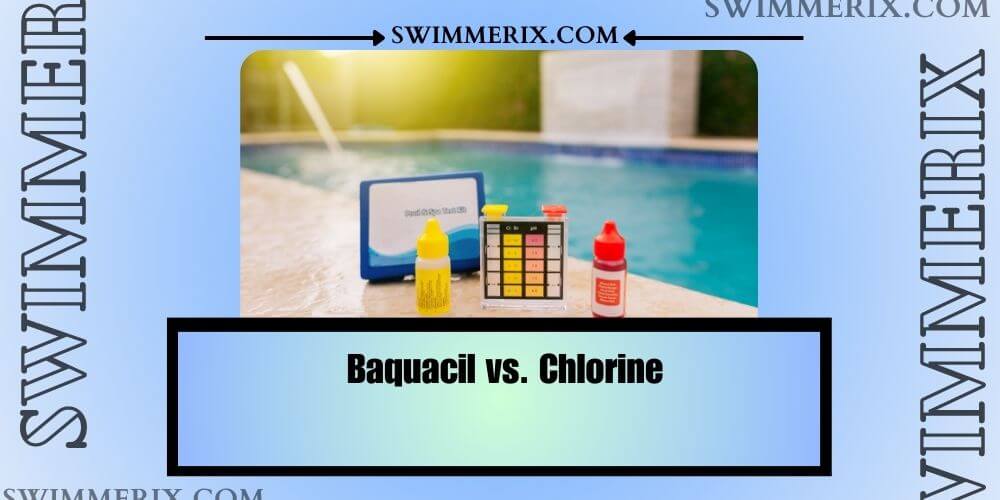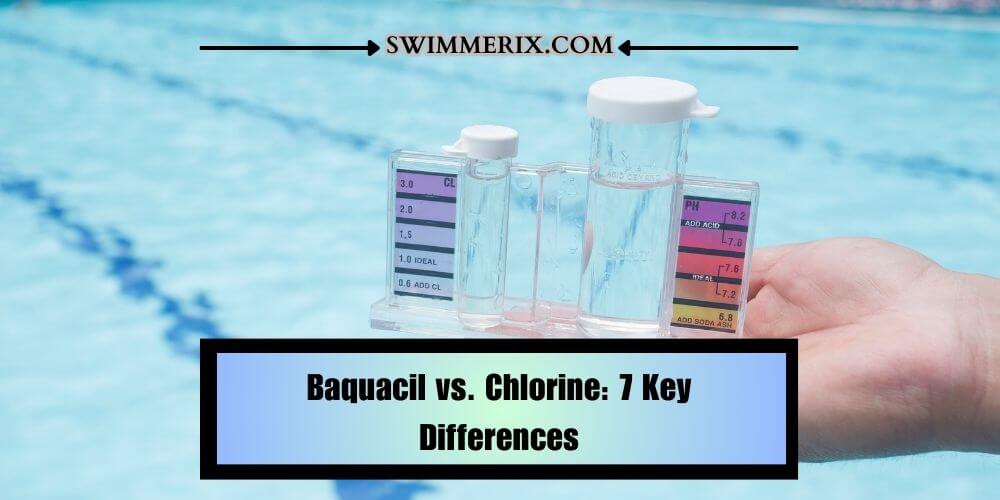
No doubt that swimming pools are a wonderful way to deal with the heat & enjoy outdoor activities, especially in the summertime. However, you must also maintain the water quality for a safe & enjoyable experience. The two most popular methods for water treatment in pools are considered to be Chlorine and Baquacil. Therefore, in this article, I will help you learn seven key differences between Baquacil vs. Chlorine to help you decide which option best suits your needs.
However, make sure you are using the information mentioned below as a general guideline because your pool might need specific chemicals for proper water cleanliness & clarity depending on its pool type, water source & many other things.
It’s also best to consult a professional about a specific design or pool type. Now, returning to the point, let’s dive into knowing seven key differences between Baquacil and Chlorine.
Baquacil vs. Chlorine: 7 Key Differences

Chemical Composition
Regarding chemical position, both Baquacil & Chlorine differ a lot, which directly affects their functionality and effectiveness in treating pooled water. You should know that Baquacils primarily consist of an active ingredient called Polyhexamethylene biguanide (PHMB), along with stabilizers & other adjectives.
On the other hand, if you look at the chemical composition of chlorine-based treatment, you will find it contains sodium hypochlorite or calcium hypochlorite as its active ingredients, along with other stabilizers & additives.
| Treatment | Active Ingredient |
| Baquacil | Polyhexamethylene biguanide |
| Chlorine | Sodium hypochlorite/calcium hypochlorite |
Sanitization Effectiveness
You must perform water treatment to ensure effective sanitization and eliminate harmful bacteria, viruses & algae. Therefore, you will find some interesting facts when it comes to knowing the sanitization effectiveness of Baquacil and Chlorine.
Baquacil is considered a non-chlorine sanitizer but is very effective against bacteria & algae. However, you should know that this kind of solution works at a slower pace compared to Chlorine & best suited to a pool that will be used later.
On the other hand, if you look at the traditional chlorine-based sanitizers, you will find them not only combating bacteria & algae but also helping eliminate viruses. Below, I am mentioning some pros & cons of Baquacil and Chlorine.
Pros of Baquacil:
- Effective against bacteria & algae.
- Suitable for individuals with sensitive skin.
- Does not cause a strong chlorine odor.
Cons of Baquacil:
- Slower acting compared to Chlorine.
- Requires precise dosage for optimal effectiveness.
- It may not be as readily available as Chlorine products.
Pros of Chlorine:
- Fast-acting sanitizer.
- Effective against bacteria, viruses, & algae.
- Widely available & easily accessible.
Cons of Chlorine:
- Potential for eye & skin irritation, especially at higher concentrations.
- Requires regular monitoring & adjustment of chlorine levels.
- It may cause a strong chlorine odor.
Water Balance & pH Levels
When it comes to water balance & pH level maintenance in your pool, it’s important to consider the chemical solution you use for optimal water quality. Baquacil is known to have minimal impact on pH level but may also require pH adjustment to keep the water balanced properly.
On the other hand, using chlorine treatment may result in pH fluctuations requiring regular monitoring & adjustment. Below, I mention some tips that can help you maintain a proper water balance in your pool.
- First, I will advise you to regularly test your pool water to ensure pH levels are within the recommended range. You can find pH testing stripes or taste kids locally at nearby Pool Baquacil or online.
- If you need to adjust the pH level, make sure to use appropriate chemicals or consult a professional
- Always have extra water testing kits to accurately monitor water balance once a week, at least before you type into the pool.
Eye & Skin Irritation
People with sensitive skin often wonder about the pool treatment due to the potential concern for eye & skin irritation. There are some valuable insights when it comes to knowing about the probability of eye & skin irritation due to Baquacil or chlorine treatment.
Baquacils are generally considered less irritating to the eyes & skin, making them best suited for individuals with sensitive skin. On the other hand, Chlorine can cause eye & skin irritations if you use it at a higher concentration.
Therefore, consider using Baquacil to treat your water if you have sensitive skin. You should know that some individuals may also experience sensitivity or allergies to Chlorine. If you find yourself in a situation of eye & skin irritation, here are a few tips to reduce & relieve it.
- First, I will advise you to rinse off before & after swimming to minimize chemical exposure.
- It is best if you apply a moisturizer or lotion after swimming to keep your skin hydrated all the time.
- I usually like to use swim goggles & swim caps to protect my hair & water. Make sure to do that as well for yourself.
Cost Considerations
If you’re looking to choose a water treatment option for your pool, the cost is another factor you should consider. Baquacil is considered a higher initial investment due to the cost of Baquacil products. However, you will have to use fewer chemical additions over time if Baquacil is used, potentially offsetting the initial expense.
On the other hand, Chlorine is known for having a lower initial cost but comes with ongoing expenses for chlorine products & maintenance chemicals which add later. Therefore, you should first calculate the long-term expense of both Baquacil & chlorine treatment, including the cost of treatment, chemicals balance & any other additional equipment.
Also, make sure to consider the frequency of chemical additions & the overall lifespan of the treatment method to make an informed decision on what treatment is best suited for your pool & your well-being.
Environmental Impact
Since our world is becoming more environmentally conscious, it is also important that we consider the impact of pool treatment on the environment. When using environmentally friendly chemicals to treat water & make it safe for swimming, Baquacil tends to be the best as it is non-chlorine based.
On the other hand, chlorine treatments are said to have the potential for chlorine by-products and environmental contamination if you don’t handle or dispose of it properly. Below, I’m mentioning some eco-friendly pool maintenance tips you can employ if you are environmentally conscious.
- Invest in a good quality pool cover to minimize water evaporation during hot, scotch sunny days & reduce the need for chemical addition.
- Consider alternative sanitization methods like saltwater systems or UV sterilization if you want a more eco-friendly option.
- Be careful when disposing of used chemicals. Make sure to follow local regulations & guidelines to dispose of.
To get an estimate of how much chlorine to use, check my post on “How Much Liquid Chlorine Do You Need for Your 15000 Gallon Pool“
Ease of Use & Maintenance
Lastly m, another thing that you need to consider when deciding which one is best suited for your pool is the ease of use & maintenance requirement. These things are essential considerations for all pool owners.
I have found that Baquacil requires less frequent testing & chemical adjustment compared to chlorine treatments. Plus, pool sometimes fail to hold chorine, and if this is the case, read “Why Pool Won’t Hold Chlorine” and what to do about it.
Also, If you are worried about staining or bleaching the pool surface, consider Baquacil. If used correctly, Baquacil is less likely to cause any bleaching or staining of the pool surface.
If you have a pebble tec surface, consider reading my recent article on Pebble Tec Problems, where we discussed pebbles coming off the surface due to low-quality chemical or chemical imbalances & solutions for it.
Return to the point, ensure you follow the manufacturer’s introduction for doses & applications. Also, it is highly advised to clean the pool filter & backwash it regularly to ensure the optimal performance of circulating & filtering the water effectively. Also, it would help if you always used a pool maintenance schedule to stay organized and on top of tasks.
Conclusion
I hope now you know which one, ‘Baquacil vs. chlorine,’ will suit your pool as well as your skin type. Choosing between Baquacil & Chlorine as a water treatment for your pool depends upon factors like sanitization effectiveness, ease of use, and personal preferences.
If I were at your place, I would have chosen Chlorine for a big pool but Baquacil for a small above-ground pool. I have given my best to give you an in-depth understanding of the seven key differences between Baquacil vs. Chlorine discussed in the article to help you make an informed decision that aligns with your specific need.
Always remember to pay attention to regular maintenance & adherence to recommended practices for a clean & safe swimming pool environment. Feel free to comment below if you have any other concerns regarding what to choose between Baquacil vs. Chlorine. Do check my other helpful guide on pool water parameters. See you in the next post, till then, take care & goodbye.

